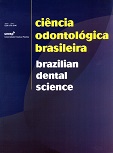Influence of the implants inclination on the accuracy of the working cast
DOI:
https://doi.org/10.14295/bds.2007.v10i2.334Abstract
The aim of this study was to evaluate the influence of the implants inclination on the accuracy of the working cast obtained by two different pouring techniques. A metallic matrix containing two implants, positioned at 90 and 65 degrees in relation to the alveolar ridge, was submitted to the direct transfer impression technique. In CP group (conventional pouring - n=10), the impressions were poured with dental stone type IV using the conventional technique. In EP group (experimental pouring - n=10), the analogs were embraced with latex tubes before the first pouring. After sixty minutes, these tubes were removed and the space was filled with the dental stone. The metallic matrix (control group) and the replicas were evaluated regarding the implant/analog inclination and the vertical misfit between a framework and the implants/analogs. The data were tabulated and analyzed using analysis of variance (ANOVA) and Tukey test at the 0.05 level of significance. Regarding the analog inclination, both experimental groups differed statistically (p<0.05) from the control group only in relation to the leaning analogs. Results demonstrated significant difference (p<0.05) between the control group and the experimental groups when the reading of the vertical misfit was accomplished in the perpendicular implant/analog with the retention screw in the leaning implant/analog and between the control group and the EP group in the opposite situation. Considering the inclination, perpendicular implants produced more accurate casts independently of the plaster pouring technique.Downloads
Downloads
Published
How to Cite
Issue
Section
License
Brazilian Dental Science uses the Creative Commons (CC-BY 4.0) license, thus preserving the integrity of articles in an open access environment. The journal allows the author to retain publishing rights without restrictions.
=================




























